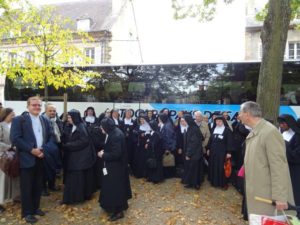
Interview with Gérard Picaud, director of the Musée de la Visitation de Moulins and his assistant Jean Foisselon
By Hélène Roquejoffre• March 24, 2020 •
The museum of the Visitation of Moulins guardian of the monastic heritage
Installed in the buildings of the former Bourbonnais museum, built in the 15th and 17th centuries in the historic center of Moulins, in the Allier region, the Musée de la Visitation presents in nine rooms more than a thousand objects from the heritage of the Visitation, a female monastic order founded in 1610 by Saint Joan of Chantal, under the aegis of Saint François de Sales. When the founder died in Moulins in 1641, the order counts
in Europe eighty-seven monasteries.
The director of the museum, Gérard Picaud, and his assistant, Jean Foisselon, present ten masterpieces from this rich and astonishing collection, unlike any other.
Unique collections in the world
Through 13,000 objects of a very wide variety, the Museum of the Visitation tells the 400-year history of a religious order that combines memories of the royal courts of Europe with the more modest intimacy of cloistered nuns.
The World of the Bible: What is the history of this unique museum?
Gérard Picaud: The Order of the Visitation has been present in Moulins since 1616. The first community left the city in 1792 under the Revolution. The visitandines did not return to Bourbonnais until 1876 at the request of Mgr de Dreux-Brézé, Bishop of Moulins. In 1991, the lack of religious vocations questioned the nuns about the future of this monastery which nevertheless preserves the memory of Saint Joan of Chantal, founder of the order, who died there in 1641. It was then that, known as historian and friend of the community, I am asked to preserve here the memory of the foundress and of the religious community present for several centuries. We thus receive some 600 objects collected in France and Belgium, which we present in the Bourbonnais museum. In 1993, the superiors of the Visitation met exceptionally in Moulins and discovered these rooms which retrace their history. Enthusiastic, some entrust new objects relegated to their attics. The closing of new monasteries between 1997 and 2000 further enriches the collections.
In 2004, the Regard sur la Visitation association was created to manage a collection that then numbered more than 4,000 objects, and no less than 13,000 today.
Jean Foisselon: Let us add that the objects remain the property of the monasteries, including that of Moulins. Because this house which was called to close in 1991 – which Rome refused – is now enjoying great vitality with the reinforcement of Visitandines from other houses. His mother superior is president of our association.
G. Picaud: Nuns do not have to be museum guardians, but they are their moral guardians. In addition, this museum manifests the “union of hearts” advocated by their founder.
J. Foisselon: Indeed, in the constitution of the order, desired by Saint François de Sales and Saint Jeanne de Chantal, the monasteries are independent. The museum brings together a common project and brings communities together. Ninety-five houses from all over the world are collaborating on this project today.
MdB: What are the museum collections made of?
G. Picaud: They are very varied: works of art, silversmiths and liturgical fabrics, archives and a number of devotional or everyday objects, present in the monasteries at different times and in different cultures. We do not embroider in the same way in Portugal and Poland. We also preserve eminently historical objects, such as this chasuble cut from the velvet which padded the royal carriage of Henri IV, or the one which was cut out of the dress that Marie-Antoinette had to wear when she entered the kingdom of France.
J. Foisselon: Since 2007, our strength is also to publish scientific works on the history and specificity of the Visitation in
through these objects. Thirteen are edited.
G. Picaud: These works are great ambassadors of this heritage to amateurs and researchers, but also to nuns who were scarcely aware of their artistic and spiritual past. Our museum is a pioneer in the conservation and transmission of monastic heritage. This is not a sacred art museum but a conservatory of the memory of an order that v it still today and is growing.
The support provided by the Drac (Regional Directorate of Cultural Affairs), the city of Moulins, the Allier department, the region, the Foundation of Monasteries, and private patrons, proves the legitimacy of our scientific approach around a unique collection in the world. Let us recall that the memory of this order is interwoven with memories closely linked to the history of France and of the great countries of Europe. Of the 13,000 objects, 1,000 can be qualified as historic.
J. Foisselon: The moral and spiritual strength of this order, based on the insistence of divine love, is that it attracts as many women from royal courts as others from modest or even very poor families. The museum tells how they invent rules of life and tips to live well together their entire existence in a cloistered space. As a result, this museum has a historical, artistic and religious dimension, but also an ethnographic dimension. We present chairs, knives, shirts, shoes that tell the story of the break in lifestyles between the 16th and 17th centuries that no one else has preserved elsewhere.
MdB: What are the challenges for the museum?
J. Foisselon: To date, we have more questions than answers. We welcome nearly 8,000 visitors a year. Despite a room outside the museum, which allows us to annually exhibit unpublished objects in original scenographies, we remain constrained in the museum even by limited and historically classified spaces. Difficult to show the advantages of objects and install modern equipment facilitating the reception of all audiences, especially the disabled. We are also challenged with the accessibility of our image bank, which is also unique in the world.
Interview by Benoît de Sagazan
Translated by website